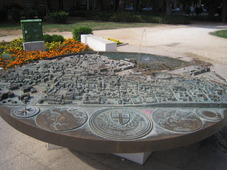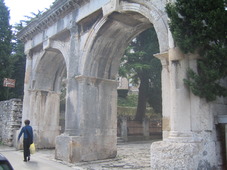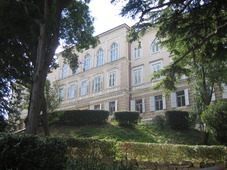to enlarge


or choose the place
from the menu below
 Rome |
 Byzantium |
 Venice |
 Vienna |
 Brioni |
 Smrikve |
 |
 |
 In the park located right after Karolina there is bronze map of Pula.
This map will give you an idea of Pula and you will see how the old town is made like a circle.
In the park located right after Karolina there is bronze map of Pula.
This map will give you an idea of Pula and you will see how the old town is made like a circle.
You will immediately recognize the Arena and the fountain you just passed nearby because a water sprinkle is placed on that building on the map.
If you’ve already visited the town I am sure that you will recognize other important Pula monuments.
If you take a look towards the old town from the park where the map is found, you will notice a street that continues in front of you, a street that goes towards the hill and another street to your left.
If you take the street leading towards the hilltop, at one-hundred meters on your right-hand side you will find the Orthodox Church of St. Nicholas dating back to the 6th century. This church was restored in the 12th century and it houses a valuable 18th century iconostas made by the Greek Master Tomios Batos.
If you turn back onto the main road on your left-hand side you will see the sea, but I suggest you take a right because just one-hundred meters away you will find one of the most beautiful Roman gates in Pula.
 These gates are called Twin Gates (“Porta Gemina”). They
are surely one of the most well preserved Roman period gates in Pula. It is likely that Pula had twelve gates during the Roman
period.
These gates are called Twin Gates (“Porta Gemina”). They
are surely one of the most well preserved Roman period gates in Pula. It is likely that Pula had twelve gates during the Roman
period.
Seven gates were located near to the sea and five gates were built inland. Three of the five inland gates have been preserved.
Near the twin gates you can see the remains of the town walls. This was the town limit during the Roman period and they were built in the 2nd, 3rd and 4th century. The first town walls were built around the prehistoric hill fort settlement on Kastel hilltop and they were built between 42 BC and 30 BC. The walls were restored during the Byzantine Empire and also during the Venetian period.
The Twin Gates were built between the end of the 1st and beginning of the 2nd century. Through them the road led to the Arena and then further to Nesactium.
Above ground level in the park located opposite to the Twin gates you will see an octagonal Roman Mausoleum dating back to the 1st century.
During the Roman period a necropolis was located on this site and there were numerous sarcophaguses and tombstones that during medieval times were used as building material.
 If you pass through the Twin gates you will once again find yourself in the old town.
If you pass through the Twin gates you will once again find yourself in the old town.
The neo-classical building that you see towards the hill is the Archaeological Museum projected by Natale Tommasi.
This building was built in 1890 and was used as a high school. In 1930 it became the seat of the Archaeological Museum.
Behind the Museum there is a small Roman theatre.
If you are interested in stopping off at the Archaeological Museum of Istria there are few collections that are worth visiting: the prehistoric collection, the Roman monuments collection, and the collection of late classical and medieval archaeological objects.